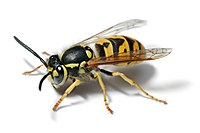
Photo from wikipedia
Summer temperature patterns within tree cavities might influence occupancy of cavities by different animals such as birds and bats, and furthermore, cavity temperatures can influence processes such as embryonic development… Click to show full abstract
Summer temperature patterns within tree cavities might influence occupancy of cavities by different animals such as birds and bats, and furthermore, cavity temperatures can influence processes such as embryonic development or the development of young. Our study aimed to identify the environmental variables influencing cavity temperatures during summer (June-July) in quaking aspen (Populus tremuloides) in southeastern Idaho. We collected temperature data between June 22 and July 27, 2015 using iButtons distributed across 30 tree cavities in 30 aspen stands in the Craters of the Moon National Monument, Idaho. We used every third day of data to ensure temporal independence amongst readings from the same cavity. We used a multi-model selection framework to examine how environmental characteristics might influence cavity thermal environments, and we modeled how environmental variables, tree, and cavity characteristics might influence daily maximum cavity temperatures. Cavity temperatures ranged as low as 1 °C to as high as 46 °C. Approximately 13% of the cavities experienced temperatures above 40 °C for at least an hour, and these temperatures are noted to be lethal to developing avian embryos. The two top competing models explaining the daily maximum cavity temperatures included tree diameter at cavity height, canopy cover, cavity orientation, and daily maximum ambient temperature. Daily maximum cavity temperatures were significantly associated with daily maximum ambient temperatures and canopy cover; warmer cavities were positively associated with warmer ambient temperatures and negatively associated with canopy cover. Because cavities in aspen are an important resource for multiple species, understanding the factors that influence the microclimate of tree cavities can have broad implications for cavity using species in the context of changing climates.
Journal Title: Journal of thermal biology
Year Published: 2019
Link to full text (if available)
Share on Social Media: Sign Up to like & get
recommendations!